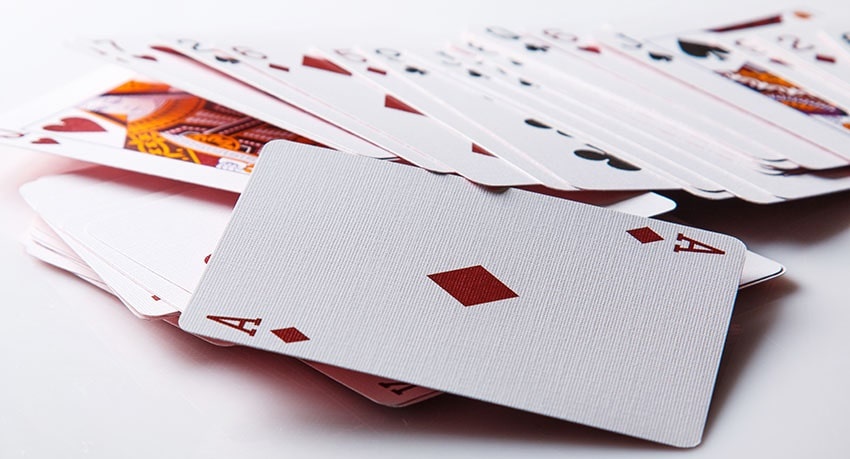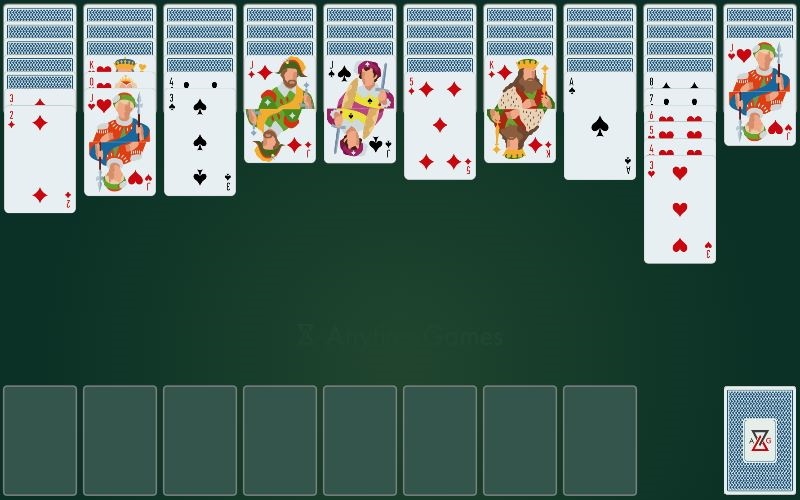Spider Solitaire is a fun, exciting, and relaxing game. Here’s the guide for beginners and the complete rules.
Spider Four Suit Rules
Objective
Let’s dive into the rules of the Spider Solitaire (patience) card game, including how to play, and how to win. We’ll start by going over the rules of Spider 4 suit, and then go on to discuss the Spider 1 suit and Spider 2 suit variations.
The objective is to arrange all the cards in a suit in descending order from the king to the ace. Once you complete this goal, remove the entire run from the tableau and place it into one of the eight foundations. If you're able to successfully empty the table of all cards, congratulations! You've won the game.
On the other hand, if you've depleted the stockpile and you're no longer able to make any moves, you've lost — better luck next time.
Setup
Spider Solitaire setup requires a spacious playing area, so make sure you have one before you start playing.
You play Spider Solitaire with two complete decks (except for the jokers) for a total of 104 cards. To start, shuffle the cards. Then, deal out 54 cards to 10 columns along a horizontal line. The first four columns will have six cards, while the other six will have five cards. Keep on dealing until you've dealt all 54 cards. This layout is known as "the tableau".
Place each new card slightly lower than the card you're playing it on. That way, you can see the value and suit of each previously played card. Turn the top card of each column face up. Place the remaining 50 cards in a stockpile at the top of the game board.
Leave enough room for eight more columns above or below the tableau. This is known as "the foundation", and it's where you'll be moving your completed sequences.

How To Move Cards
In Spider Solitaire, you can move a card onto a card that's one higher in rank. For example, you can place a 10 of hearts on top of a jack of hearts, spades, diamonds, or clubs. However, keep the game's objective in mind when you do so, which is to create sequences in the same suit. Because this is the only way you're going to win, this is where your efforts should lie.
Unfortunately, unlike most other Solitaire games, an ace is only counted as "1" and never as "11". Of course, this is going to limit your strategic possibilities a bit. This is just one of the things that makes Spider Solitaire more challenging than many other Solitaire games.
At times, you'll want to move cards to get them out of the way so you can build the sequence you want. You can only move cards in a row as a single unit to another pile if they're all in the same suit and in descending order.
This means that if you have the five of diamonds, four of diamonds, and three of diamonds all in a row, you can pick them all up and move them to another column. However, that column will need to either have a six of diamonds on top of it or be empty.
Drawing cards from the stockpile could cause you to end up with sequences that are no longer ordered, potentially throwing a monkey wrench into your strategic plans. For example, if you have a queen of diamonds on top of an eight of clubs and a nine of clubs, you won't be able to move the eight and nine as a unit until you move the queen first. The good thing is that even if a card or sequence is blocked, you can continue to build a sequence below it.
For instance, in the above scenario, you can place a jack of diamonds on top of the queen. Move the queen/jack combo as soon as the opportunity presents itself, so you can expand the eight of clubs/nine of clubs sequence until you have a winning run.
You'll need to turn the top face card over if only face cards are left in a column. If there's an empty column on the table, you can move any cards to it (we'll discuss the importance of empty spaces in the next section).

The Value of Empty Spaces
Empty spaces provide you with maneuvering room and give you more possibilities for gameplay. That's why it's crucial to look for ways to create empty spaces by removing columns, which will boost your chances of winning. For example, placing a king in an empty column ensures that the king won't block any other cards.
Drawing Cards from the Stockpile

You're free to draw 10 cards from the stockpile if you can't make any more moves. If you decide to draw, one card goes on each of the 10 columns. You'll draw from the stockpile five times throughout the game for a total of 50 cards.
It's crucial not to do this until you're 100% sure no more moves are possible. Take your time and look at all the possibilities before deciding to do this. The other thing you need to keep in mind is that you can't take cards from the stockpile unless there's at least one card in each column.
However, there's a way around this: moving cards from a full column to an empty one. Then, you can draw cards. If fewer than 10 cards are in play, you won't be able to have at least one card in each column. This means you won't be able to draw, and the game is over unless you're able to do something with your remaining cards.
Scoring
You start the game with 500 points. Every time you make a move, subtract one point from this total. You also get 100 points for each sequence you remove from the table. For example, if you can make four sequences in 50 moves, your score will be 500-50+4*100=850 points.
Winning
Once you complete a sequence, you move those cards out of the tableau and game into one of the eight foundations. Fill up all the eight foundations, and you win the game. Now that you know the rules, why don’t you play the Spider Solitaire card game online now?
Spider One Suit
Spider Solitaire is notorious for being challenging for newbies. That's why if you're just learning how to play, you should probably start out by playing the one-suit variation before diving into the four-suit version. The layout and the rules are pretty much the same, and you'll still use 54 cards. However, when you’re playing Spider One-Suit, you’ll only use spades.
Spider Two Suit
You can also play a two-suit variation. Here, you’ll play with spades and clubs. You can also play a two-suit version where you treat all cards of the same color as the same suit. In this variant, you'll use all four suits, but you'd count spades and clubs as one suit and hearts and diamonds as one suit.
Spider 1 and Spider 2 Suit are variations that greatly simplify the game, allowing you to learn the rules better. Once you do, you'll be able to more confidently tackle the four-suit version. If you want to try your hand at another exciting Solitaire variation, play Golf Solitaire online!
Are There Other Variations?
There are many Spider Solitaire variations, and each one has different rules and ways to win. For example, you can play one deck Spider Solitaire. In this version, you'll play with six stacks of cards — two stacks of six cards and four stacks of five cards.

Here are some other variations:
- GIGANTIC SPIDER: In this variant, you'll use four decks.
- TARANTULA: In this version, you'll lay out ten columns instead of eight. Deal 54 cards to these stacks — six cards in the first four piles and five cards to the remaining ones.
- RELAXED SPIDER: This is just like the regular game, except you won't have to ensure all columns have a card before drawing from the stockpile.
- SPIDERETTE: This is another one deck variant. You'll have seven columns with one to seven cards in each one.
- MRS. MOP: Deal all the cards face up when playing this interesting variant.
- SPIDERWORT: This version uses three decks.
- WILL O' THE WISP: A guy named Geoffrey Mott-Smith invented this version. It's played the same way as Spiderette with one exception: you deal 21 cards into seven columns of three cards.
These are just a few Spider Solitaire variations. Play Clock Solitaire if you want to try yet another fun spin on the basic Solitaire game.
Luck or Skill — Which is More Important?
To win at Spider Solitaire, you'll need equal amounts of luck and skill. Not every hand is winnable, no matter how skilled you are at the game. Computer experts have done an in-depth study of Spider Solitaire, and they've found that the chances of winning are approximately one in three.
Interesting Facts About Solitaire (Including Spider Solitaire)
Solitaire is derived from the Latin word solitarius, meaning "isolated" or "alone". Originally, a "solitaire" was a widow. Later, the term was used to signify a solitary person. It wasn't until the 1700s that it evolved to mean card game.
There are five major variations of Solitaire: Spider Solitaire, Klondike, TriPeaks, Pyramid, and FreeCell. However, there are hundreds of sub-variants of these games. The highest score you can get in a classic solitaire game is 24,113.
Spider Solitaire grew wildly popular after being included in the Microsoft Plus! 98 addition pack for Windows 98. However, John A. Junod, the original developer of WS_FTP, wrote an early version of the game in 1991. Ian Heath, a computer science professor at the University of Southampton in the UK, wrote a similar game called Arachnid, which means "spider" in Greek, for Windows 3.x.
Spider Solitaire's only thing in common with an actual arachnid is that a spider has eight legs, and the game uses eight discard piles. The first mention of the game was in the magazine Games Digest in 1937. Back then, they called it Spider, and it only had a 50-card tableau. However, there's significant evidence this game was avidly played in the early 1930s.
One of the most interesting origin stories of a solitaire variant is "Cribbage Solitaire". The idea for this version occurred to a guy named Bill Beers while he was a patient in a psychiatric hospital. The hospital believed that playing cards could be used as a weapon of sorts. This led Beers, an avid Solitaire player before arriving at the institution, to come up with a version that he could play with the other patients.
He was forced to use thick tiles that were bulky and hard to handle. This game, a hybrid between card-based Solitaire and cribbage, requires knowing basic cribbage combinations.
Benefits of Playing Solitaire
The benefits of playing Solitaire go beyond merely killing time and getting lost in a momentary and enjoyable diversion. That's because there are psychological dividends to playing this addictive game.
Studies have shown that playing Solitaire can lead to significant improvements in your cognitive function, memory, and overall brain health. It's perfect for the elderly who want to retain their mental sharpness well into their golden years. If playing Spider Solitaire whetted your appetite for more card-flipping fun, why don’t you play Tri Peaks Solitaire?


